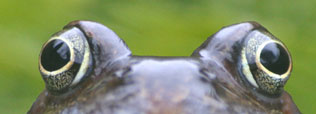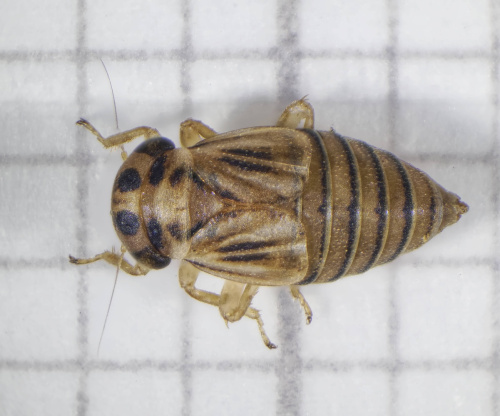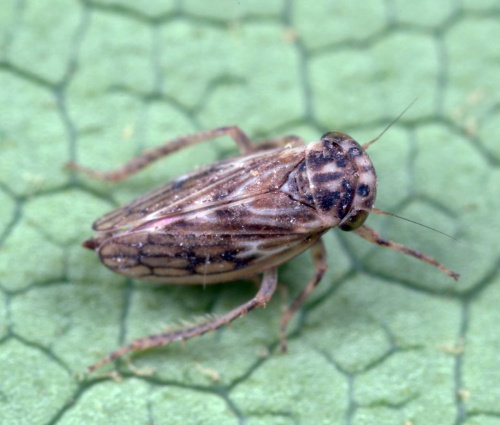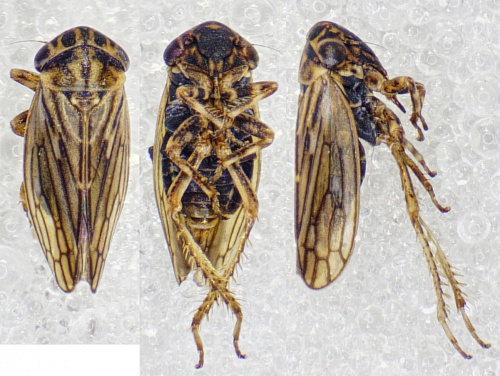- Home
- Bugs
- Leafhoppers, planthoppers and allies (Auchenorrhyncha)
- Cicadellidae - leafhoppers (Agallinae)
All images on this website have been taken in Leicestershire and Rutland by NatureSpot members. We welcome new contributions - just register and use the Submit Records form to post your photos. Click on any image below to visit the species page. The RED / AMBER / GREEN dots indicate how easy it is to identify the species - see our Identification Difficulty page for more information. A coloured rating followed by an exclamation mark denotes that different ID difficulties apply to either males and females or to the larvae - see the species page for more detail.
Bugs
Insects in the order Hemiptera are the 'true bugs'. They are unique amongst insects in having their mouthparts formed into a piercing beak or 'rostrum', used to suck juices from plants or other animals. Their life cycles do not have a larval and pupal stage; instead, juvenile bugs have a series of nymph-stages or 'instars', which progressively have more adult-like characteristics. Hemiptera are divided into distinct sub-orders:
- Heteroptera include the shield-bugs, plant bugs, ground bugs, water bugs and allied families. These have a thickened and opaque basal part to their forewings, with a transparent outer part.
- Auchenorrhyncha are the leafhoppers, planthoppers, cicadas and allies. Some authorities divide this into two separate sub-orders: Cicadamorpha and Fulgoromorpha. Many have enlarged back legs and can jump.
- Sternorrhyncha are aphids, psyllids and allies.
Leicestershire and Rutland resources
- LESOPS 27 - A Two Year Study of Water Bugs at Priory Water, Leicestershire - (2011) Tony Cook, Frank Clark
- LESOPS 63 - VC55 Terrestrial Heteroptera. Part 1: Recorders and Recording (2024) Sue Timms, Kate Nightingale & Alan Cann
- LESOPS 64 - VC55 Terrestrial Heteroptera. Part 2: Provisional Checklist (2024) Sue Timms, Kate Nightingale & Alan Cann
- LESOPS 67 - Checklist of aquatic and semi-aquatic Heteroptera in VC55 (2025) Sue Timms, Kate Nightingale & Alan Cann
Other useful websites and publications
- Facebook Group: UK Hemiptera
- The British Bugs web site is one of the best of all online wildlife guides. If you are unsure which part of the insect the description refers to, see https://www.britishbugs.org.uk/bug_bits.html
- Facebook group for Aphids, Psyllids, Scales & allies (Hemiptera, Sternorrhyncha)
- UK Shield Bugs Yahoo Forum - it is free to join then you can access the photo library and ask for identification help.
- Identifying common British aphids - very useful photo guide with excellent ID information.
- Video: Introduction to UK True Bugs from The Tanyptera Project.
- LRES video: Water bugs and their allies
- Aquatic Heteroptera Recording Scheme website: https://aquaticbugs.com
If you know of other websites or books that you would recommend, do let us know: info@naturespot.org
Leafhoppers, planthoppers and allies (Auchenorrhyncha)
The Auchenorrhyncha are split in two sections: Cicadomorpha include froghoppers (Aphrophoridae and Cercopidae), leafhoppers (Cicadellidae), treehoppers (Membracidae) and cicadas (Cicadidae); Fulgoromorpha are the planthoppers (Delphacidae, Tettigometridae and Issidae) and lacehoppers (Cixiidae). Unlike the Heteroptera, the forewings are not divided into two parts, but may be hardened or membraneous. Coloration and extent of markings can be very variable, especially on the vertex and frons ('nose' and face) and the pronotum and scutellum. Leafhoppers, planthoppers and froghoppers can jump strongly, using powerful hindlegs. Many species have short- and long-winged forms (brachypterous and macropterous); long-winged individuals can fly and may travel long distances, allowing dispersal and colonisation of new areas. They do not have a pupal stage in ther lifecycle; the immature forms or nymphs pass through several instars, each increasing in size and adult characters before becoming adults.
They feed exclusively on plant sap, using their sucking mouthparts. Many species feed on a specific plant species, or a narrow range of hosts. This can help identification and with targetting surveys, and it is recommended that the host plant is always noted in your record. Feeding in the UK can cause minor damage to plants - the characteristic stippling of leaves of roses, for example - but they can be serious economic pests in other countries.
Many species show sexual dimorphism - the males and females are different in size and coloration. Identification of some species can be very difficult, often involving dissection of the male to examine the internal genitalia - the aedeagus and parameres. The 'aedeagus' is a chitinious structure, often of very complex shape, analogous to the penis in mammals. The 'parameres' are also known as the anal styles or claspers. Females are often more difficult to identify, and are sometimes impossible.
Recommended resources:
- More information on ecology, life-cycles etc. and current UK checklist (2021) can be found at https://www.ledra.co.uk/index.html, the website of the Auchenorrhyncha Recording Scheme for Britain and Ireland.
- British Bugs website has a photo gallery, but note that not all UK speces are shown - and not all can be identified from field photos. The UK checklist (2021) can aso be found here.
- True Hoppers WP has illustrations of hoppers from the Western Palaearctic, including many British species.
- Biedermann,R. and Niedringhaus,R. (2009): The Plant- and Leafhoppers of Germany - Identification Key to all species (WABV). The English translation of this comprehensive book is essential for serious recording. It has detailed drawings of the majority of British species, showing diagnostic features including male and female genitalia.
- Wilson et al (2015): The Plant- and Leafhoppers of Britain and Ireland - Identification keys to all families and genera and all British and Irish species not recorded from Germany. (WABV). This incudes the few UK species not in Biedermann and Niedringhaus.
- Kunz et al (2011): Fotoatlas der Zikaden Deutschlands (WABV). Not translated from German but includes photographs of the species in Biedermann & Niedringhaus.
- Le Quesne's RES Handbooks: Fulgoromorpha (1960); Cicadamorpha, excl. Typhlocybinae and Deltocephalinae (1965); Deltocephalinae (1969); and Typhlocybinae (1981 - with K R Payne). This series of 4 Royal Entomological Society publications on Auchenorrhyncha is available to download from the RES website or can be found second-hand. These have detailed keys to species, but be aware that taxonomy may not be up-to-date, and some recent changes or additions to the UK fauna are not included. Typhlocybinae includes the UK checklist at the time; this has now been updated - see Ledra or British Bugs websites (links above).
Cicadellidae - leafhoppers (Agallinae)
Most of the species in this small sub-family are found in grasslands. The sub-family has distinctive markings, but identification to species may involve dissection of the male to examine internal genitalia.
In the accounts below, an exclamation mark after the red camera icon indicates that only males can be identified






